What is Udon?
Udon is a Japanese food made with noodles that are kneaded from wheat flour, cut into long strips, and have a certain width and thickness.
Udon is generally written "うどん" in Japanese.
Udon has long been eaten throughout Japan as a simple, easy-to-prepare dish for the masses, as a substitute for rice, and as a food served on festive occasions.
It is also unique in that the recipe and ingredients used vary from region to region in Japan.
Noodles thinner than udon are generally divided into two categories, hiyamugi and somen, but there are no strict specifications for dried noodles, except for the thickness.
Inaniwa udon, one famous type of udon in Japan, is made with thin noodles, and "Kishimen" and "Himokawa," two types of noodles that are thin but wide, are also included in the dried noodles category.
The History of Udon & How Udon Got Its Name
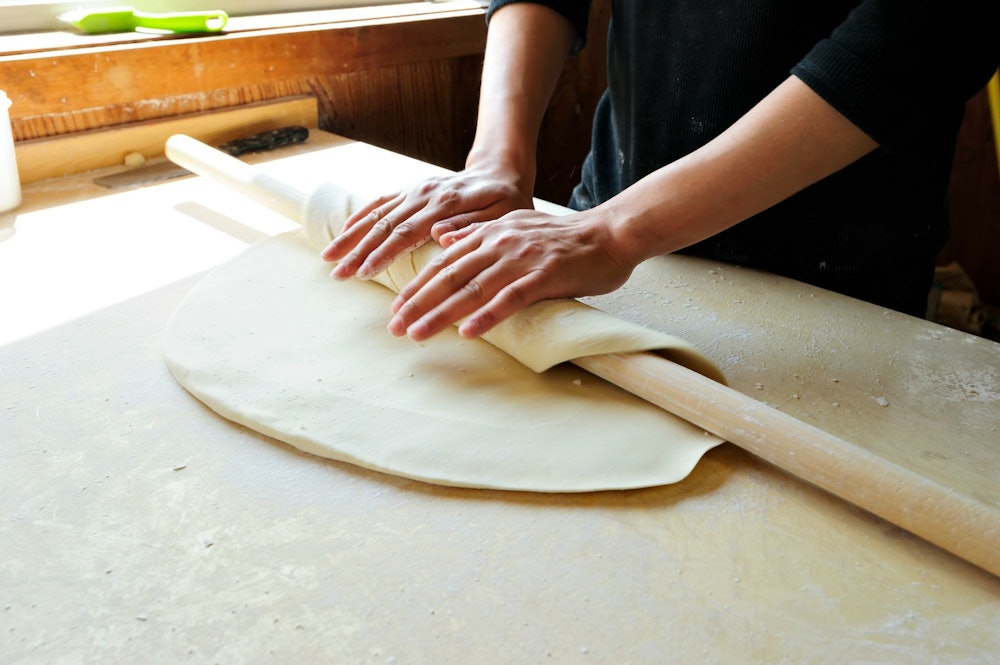
Photo:Udon being made
There are various theories on the origins of udon. Below is a list of some of them:
・Udon originated from konton, a wheat flour dumpling pastry filled with red bean paste that was brought to Japan from China by Japanese envoys to the Tang Dynasty in the Nara period (710-794).
・Udon originated from the Chinese word "wonton."
・Kukai, a Japanese Buddhist monk who traveled to Tang China as an envoy to the Tang Dynasty during the Heian period, introduced udon to Japan's Shikoku region resulting in the birth of Sanuki Udon.
In any case, udon as we know it today was widespread and widely eaten throughout Japan by the early Edo period (1603-1868).
In the past, udon was generally made by hand, but nowadays, most udon is made with noodle-making machines or the entire process is done by machine.
The name of the dish changes depending on the bowl in which the udon is served, with bowls such as "kake udon" (a basic type of udon with noodles served in a simple broth), zaru udon (a type of cold udon served on a bamboo tray), and nabeyaki udon (udon served in a hot pot).
Kake Udon, a Popular Type of Udon in Japan
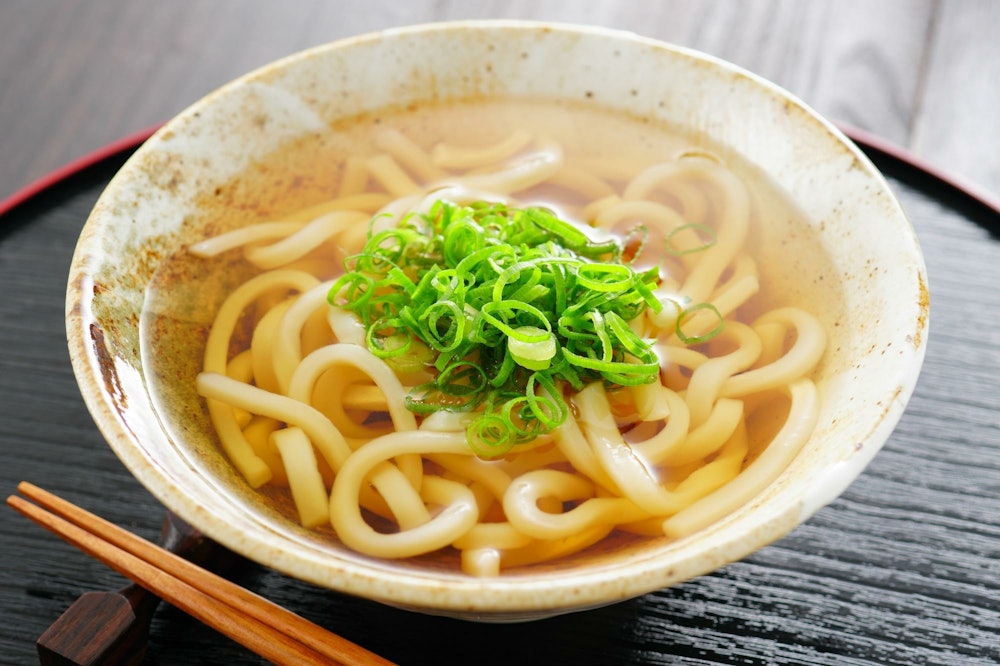
Photo:Kake udon
"Udon" refers to noodles made of kneaded wheat flour that are cut into long strips. Kake udon is a dish of boiled udon topped with hot broth. The name "kake udon" (lit. 'Topped Udon') comes from the fact that the udon is topped with dashi broth. It is mainly used in Japan's Kanto region, and is characterized by the use of dark soy sauce made from bonito (dried skipjack tuna flakes) as the seasoning for the dashi broth.
In Japan, "kake udon" is believed to be a good indicator of a restaurant's strength, as it is a simple dish consisting of only noodles and dashi broth, and no tricks can be used to make it tastier. It is eaten topped with condiments such as green onions, ginger, and tenkasu (crunchy bits of fried batter).
The Difference Between Kake Udon & Kamaage Udon

Photo:Kamaage udon
In kake udon, the udon noodles are first drained from the pot. They are then placed in a bowl of cold water, reheated in boiling water, and served with warm broth.
Kamaage udon, on the other hand, is udon that has been soaked in hot water in a kama (釜, cooking cauldron) and then eaten after being soaked in soup stock.
The name "kamaage udon" comes from the word "kamaage" (釜あげ) meaning "directly from the pot." The hot, fluffy texture and the aroma of wheat are what make "kamaage udon" so popular.
We now know that the process from boiling to eating is different, but is there a difference in calories?
According to Marugame Seimen, a restaurant specializing in udon noodles, the calorie content of kake udon and kamaage udon are as follows.
Hot kake udon (ordinary): 299 kcal
Hot kamaage udon (ordinary): 338 kcal
Both types of noodles have less calories than other udon dishes, but a comparison shows that kamaage udon has slightly more calories.
The calorie content may be affected by the use of cold water and the differences in the broths.
How Different Types of Udon Are Made
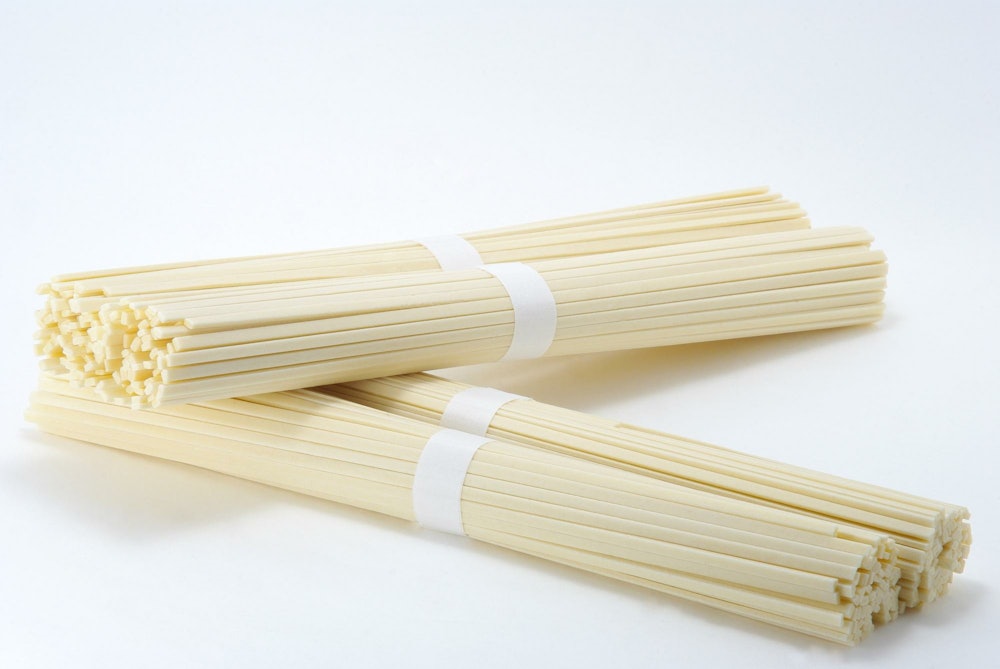
Photo:Kanmen udon noodles
There are different types of udon noodles in circulation in Japan today, including kanmen (乾麺, dried noodles), namamen (noodles that have yet to be heated or dried), and reitomen (frozen noodles), and they are boiled in different ways.
● Kanmen
Kanmen are udon noodles that have been dried and had their moisture removed. The advantage is that they can be stored for long periods of time. Kanmen are made by kneading udon dough with less water added so that the final moisture content is only around 10%. Because of the low moisture content, they can be stored for up to a year. It is recommended as a noodle to keep on hand at home.
The disadvantage of dried udon noodles that can be stored for a long time is that they are said to have an inferior texture compared to namemen or reitomen. However, if cooked in the proper way, even kanmen noodles can be enjoyed with the same chewy, yet firm, texture as namamen noodles.
The key is to put in some extra effort. Let's take a look at one way to prepare these delicious noodles.
Before boiling the udon noodles, soak them in water.
・Fill a large container with plenty of water, add the kanmen udon noodles, and soak them in the water for 10 minutes.
・Boil plenty of water in a pot and boil the noodles for their regular boiling time.
・After boiling the noodles, soak them in cold water and then rinse them thoroughly with water.
Soaking the kanmen udon noodles in water before boiling them is the key to making them taste good. Soaking the noodles in water before boiling allows them to soak up water, which may result in a shorter boiling time than normal. Be sure to check the noodles before the recommended boiling time has elapsed.
● Namamen
Namamen udon refers to udon noodles made by adding 26-35% salt water. Since they are freshly pounded, they are fresh and can be eaten immediately after boiling. However, namamen cannot be stored at room temperature and do not last very long, even when refrigerated.
The reason for this is that the high water content in fresh noodles activates enzymes, which over time cause the wheat aroma to deteriorate, as well as discoloration and changes in texture.
● Han-nama Udon
To compensate for the weakness of namamen udon, which is not suitable for long-term storage, a drying process is added to reduce the final moisture content of han-nama udon. Because the moisture content is reduced by drying the namamen udon, han-nama udon can be stored at room temperature and can be kept for about one to two months.
● Reitomen
Reitomen refers to noodles that have been frozen after boiling. They can be stored for a long period of time in the freezer, and are easy to eat by simply defrosting them when you want to eat them.
Since there is no need to boil them, reitomen noodles can be added to udon noodle soup, or they can be defrosted by heating them in a microwave oven for a few minutes without using a pot or other device.
Reitomen udon noodles can be stored for a long time and can be purchased at convenience stores and supermarkets across Japan. They are ideal for when you are short on time and want a quick meal, so it is convenient to keep them on hand.
Reitomen udon noodles can be stored for a long time, but be careful not to change the temperature in the freezer as much as possible, as this can cause the freshness of the noodles to deteriorate. Also, be sure to eat them within the expiration date indicated on the product.
How Udon Soup Stocks Are Made in Various Parts of Japan

Photo:Udon dashi
The major difference between udon made in Japan's Kanto and Kansai regions is in the dashi and tsuyu.
The first difference is the dashi, a type of soup stock common in Japanese cooking. Udon made in Japan's Kanto region is made from katsuoboshi (dried skipjack tuna flakes), while udon made in the Kansai region is made from kelp.
There is also a visual difference between Kanto and Kansai udon. That is, the color of the tsuyu, a common dipping sauce or soup base that is used in Japanese cooking. Kanto udon uses dark soy sauce, which gives it a darker color, while Kansai udon uses light soy sauce, which makes the tsuyu lighter and more transparent.
Here, we will briefly explain the difference between dark and light soy sauce. Dark soy sauce is the most commonly used soy sauce, and when a recipe calls for "1 tablespoon of soy sauce," it is referring to dark soy sauce.
The second major difference between the two is that light soy sauce has a higher salt content than dark soy sauce. Light soy sauce has a clean taste and reduced color and aroma, allowing the color and flavor of the ingredients to shine through. It is suitable for soups, chawanmushi (a Japanese steamed egg custard dish), wakatakeni (simmered bamboo shoots), etc.
Dark soy sauce, which has a lower salt content than light soy sauce, is characterized by its rich taste and aroma, and is used for dishes that require a full-bodied flavor. It is the perfect soy sauce for fish dishes with a fishy smell, sukiyaki, hiyayakko (chilled tofu), etc.
Mentsuyu, which is often used for dishes that require short cooking time, is made by adding mirin (sweet cooking sake), sugar, dashi, and other ingredients to dark soy sauce.
Here, we will show you how to make udon tsuyu using men-tsuyu that can be purchased at most grocery stores in Japan.
● Udon Tsuyu Recipe
Water - 200 ml
Mentsuyu (double concentrated)
Simply put the above ingredients in a pot and bring to a simmer over medium heat.
Udon dashi is also available in liquid form in supermarkets, so it is recommended to use that as well.
Now that you know about the two different types of udon dashi in Japan (the rich Kanto style, combining dried skipjack tuna flake-based dashi with dark soy sauce for a rich flavor, and Kansai style, which combines kombu-based dashi with light soy sauce for a light flavor) you can understand that there are differences in udon dashi and tsuyu due to the influence of the food culture cultivated in each region.
Some udon cup noodles sold in convenience stores and supermarkets in Japan are different because of the Kansai- and Kanto-style differences, so if you have a chance, be sure to try different kinds.
The Best Condiments & Toppings for Udon
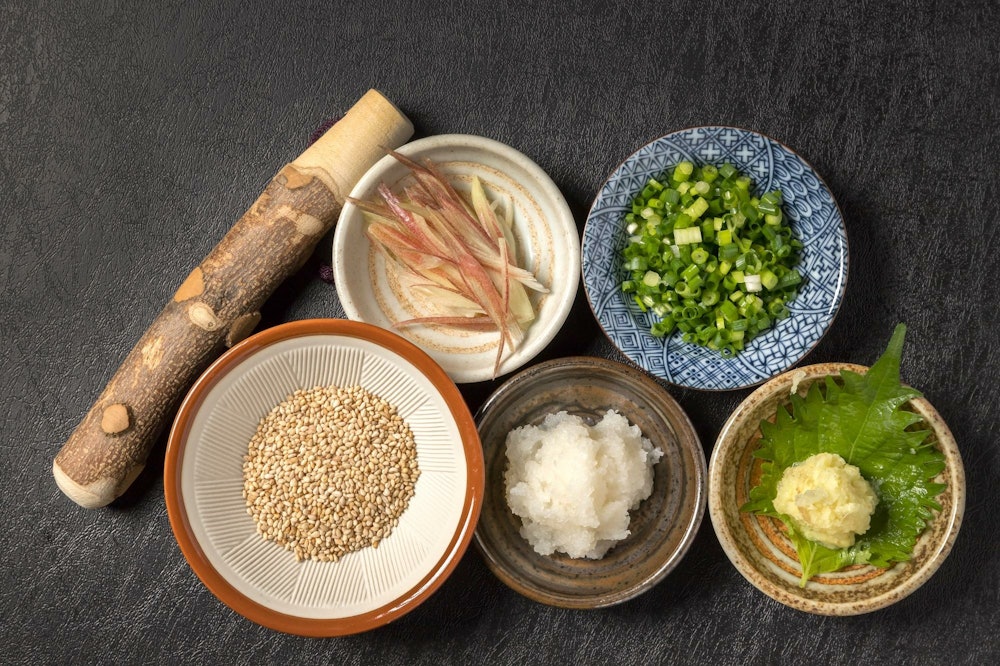
Photo:Spices
Udon noodles are delicious even without any extra spices or toppings, but there are endless ways to enjoy udon by using different condiments and toppings.
Popular toppings and condiments that enhance the flavor of udon include green onions, grated ginger, tenkasu, and ground sesame. Furthermore, adding toppings such as tempura and onsen tamago (hot spring eggs) will not only enhance the flavor but also improve the nutritional balance of the dish.
Some udon dishes have even earned their names from their toppings. One of the most notable of these udon dishes is kitsune udon, which is udon topped with deep-fried tofu.
The name "kitsune udon" (lit. 'Fox udon') comes from the fact that deep-fried tofu was a favorite food of the fox, which has long been considered a lucky animal that brings prosperity to business in Japan.
Next, udon topped with tenkasu (small pieces of deep-fried batter leftover from cooking tempura) is called "tanuki udon." The name is said to come from the word "tane-nuki," meaning "seedless," which is a reference to how the main part of the tempura (the seed) is missing, leaving only tenkasu.
Additionally, in Kyoto, "ankake udon" topped with chopped deep-fried tofu and kujo leeks (green onions) is called "tanuki udon," so be sure to keep this in mind when ordering it.
Next, we will introduce toppings available at convenience stores in Japan. First, in terms of dried ingredients, katsuboshi (dried skipjack tuna flakes) and tororo kombu (shredded kelp) are two of the most popular. Adding them to kake udon will enhance the flavor dramatically. Retort curry (pre-cooked curry in a pouch) can be added to make curry udon as well.
If you want a hearty dish to fill up with, try adding rice cakes or chikuwa (a type of Japanese fish cake). For something different, you can try adding takoyaki (fried balls of batter with octopus inside) or akashiyaki (small round dumplings from Akashi, Hyogo), which are sold as frozen foods. This may seem like an unexpected combination, but it is a voluminous and highly recommended topping.
Yaki Udon & Hiyashi Udon – 2 More Varieties of Udon
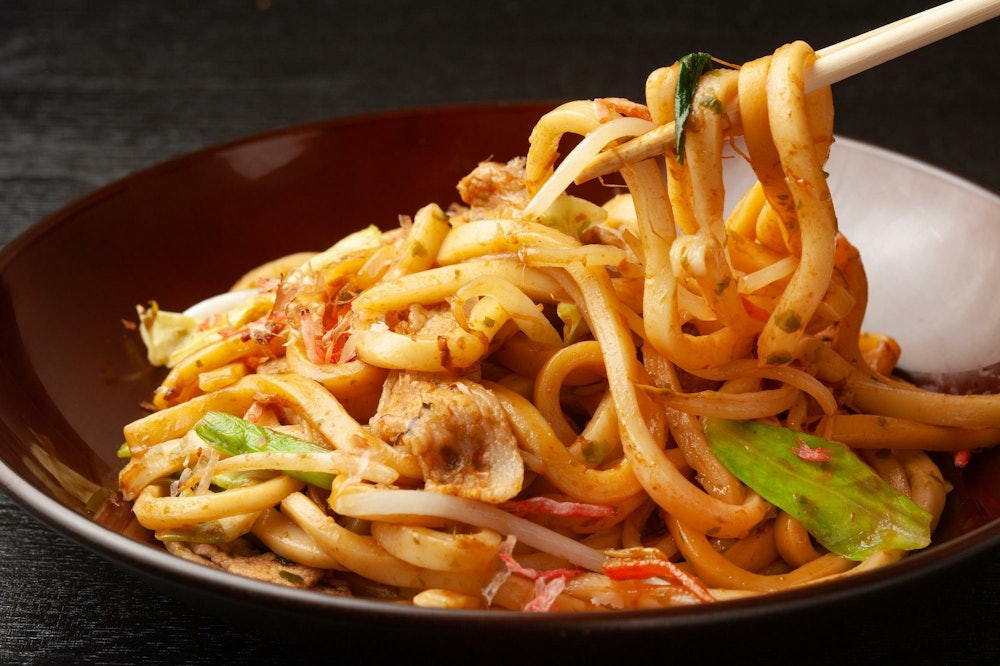
Photo:Yaki udon
Udon noodles are easy to prepare and can be arranged in a wide variety of ways with different flavors, ingredients, temperatures, etc.
Yaki udon is a dish in which udon noodles are stir-fried with meat and vegetables and seasoned with soy sauce or other sauces. It is said to have originated in the dining district of Kitakyushu, Fukuoka, just after the end of World War 2 in 1945. Immediately after the end of the war, when food was scarce and soba hard to come by, yakisoba could not be made. Instead, dried udon noodles were used as a substitute and baked like yakisoba. It became popular for its delicious taste, and yaki udon became a common dish.
The appeal of yaki udon is the texture of the thick, chewy noodles and the rich flavor of the sauce.
It is also a nutritious meal thanks to the crunchy vegetables and juicy meat.
There are two main types of yaki udon sold in Japan: soy sauce-flavored and sauce-flavored. The most common ingredients are cabbage and pork belly. Other ingredients such as carrots, bean sprouts, seafood such as shrimp and squid, and jelly ear mushrooms also go well with this dish. When stir-frying, use vegetable oil, water, cooking sake, salt, and pepper.
Hiyashi udon (chilled udon) is udon noodles with cold dipping sauce. When udon noodles are cooled in cold water and enjoyed with cold broth, the firmness of the udon is enhanced giving it a simple yet enjoyable flavor and texture.
There are various definitions of hiyashi udon, but in general, it is udon that is chilled in ice water and then dipped in tsuyu. Because the water is not removed from the noodles, the rich tsuyu gradually becomes thinner as you continue to eat, but the udon will remain cold until the end of the meal.
Hiyashi udon is recommended during the hot summer months or for those who just want to enjoy some cold, firm noodles.
A Healthy Udon Recipe
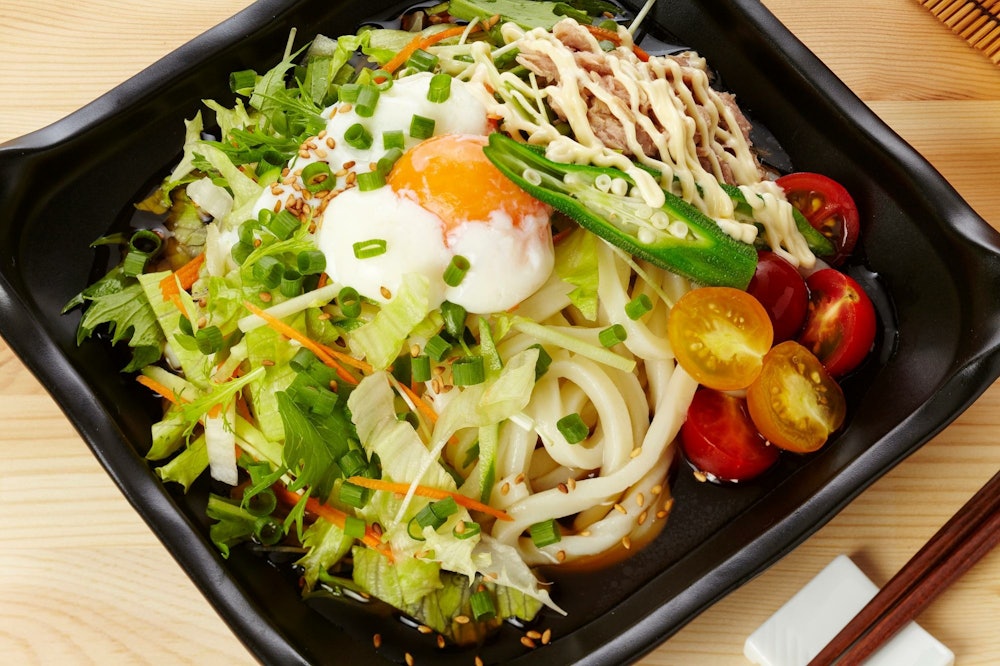
Photo:Udon salad
Low in calories, sugar, and fat compared to soba and white rice, udon is actually great for dieting.
It is especially recommended for those who want to lose weight without strain while eating a proper staple food.
Udon is reasonably priced, readily available at convenience stores and supermarkets, and takes less time to prepare than rice. Another reason why udon is suitable for dieting is that it can be prepared in a wide variety of ways, allowing you to eat it again and again without getting tired of it.
By simply using a variety of toppings, ingredients, and condiments, it is easy to create a nutritionally balanced meal. We recommend eggs, green onions, wakame seaweed, and sansei (a variety of different vegetables used in Japanese cooking).
Vitamin B1 in eggs supports the metabolization of carbohydrates, green onions help prevent lifestyle-related diseases and eliminate obesity by suppressing increases in blood sugar levels, and wakame, rich in dietary fiber, is a strong ally for dieters as it makes you feel full.
Kakitama udon (udon noodles in an egg soup) with ginger is a simple yet popular recipe that warms the body as well. The gingerol contained in ginger, improves blood flow and boosts the metabolism. We also recommend adding mitsuba (Japanese wild parsley) and green onions as toppings.
Topping with okra, mekabu (a type of thick wakame seaweed), nagaimo (Chinese yam) and ume boshi (pickled plum) are great toppings for bukkake udon (chilled udon noodles with a cold dashi sauce). The sourness of the umeboshi will stimulate your appetite. It goes down smoothly, so try it on a hot summer day when you don't have much of an appetite.
In addition, since udon soup contains salt, soup-less udon is lower in calories and healthier. Yaki udon with plenty of vegetables, such as cabbage, bean sprouts, and carrots, is a perfect evening meal because the volume is satisfying even with less noodles.
Here is a healthy recipe that is full of vegetables and nutrients.
● Salad Udon Recipe (serves 2)
・Udon noodles - 2 balls
・Tuna - 1 can
・Boiled eggs - 2
・Mentsuyu - 2 tablespoons ※Serves 2
※The following toppings can be added in any quantity you like.
・Lettuce
・Tomatoes
・Cucumber
・Avocado
・Katsuoboshi
・Green onions
・Shredded nori seaweed
1. Cut the vegetables for toppings into bite-size pieces
2. Drain the oil (water) from the canned tuna
3. Boil the udon noodles, cool in cold water, and drain
4. Place udon on a plate, top with vegetables and other toppings, and pour mentsuyu over the udon
Only mentsuyu is used as a flavoring, but if the vegetables and other toppings are still covered in water it can cause the flavor to be diluted. If you want to add a little richness, you can try adding mayonnaise, a popular condiment in Japan. Keep in mind that this will affect how healthy the dish is.
Udon vs Soba vs Ramen Noodles: Appearance, Shape, Flavor + Calories and Other Nutritional Information
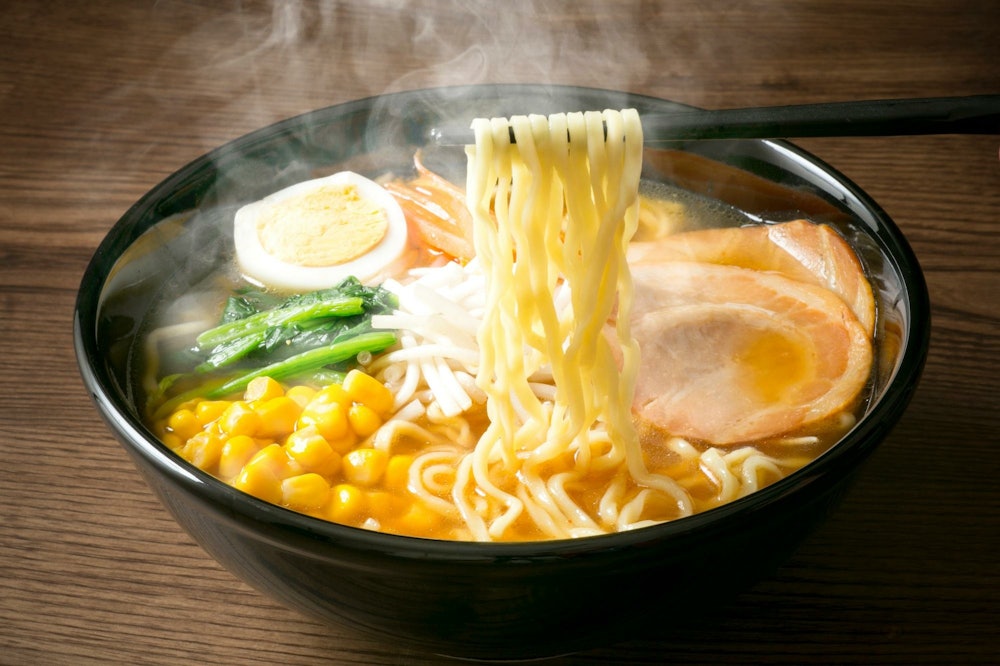
Photo:Ramen
When people think of typical Japanese noodles, udon, soba, and ramen are generally the three types that come to mind. These noodles all differ slightly in their ingredients. Udon is made from plain wheat flour, salt, and water.
Ramen noodles, similar to udon noodles, are made from wheat flour, but mixed with "kansui," an alkaline solution, to give them firmness and flavor.
On the other hand, the main ingredient of soba is buckwheat flour, which is made by grinding buckwheat seeds. Buckwheat flour is used for more than 30% of the total mixture, and wheat flour is added as a binder, with the exception of a few special types of soba.
Besides how each type of noodle is made, udon, soba, and ramen noodles are relatively easy to distinguish from one another. Udon noodles are generally thick and have a white color.
Ramen noodles usually have a yellow coloring to them due to the use of kansui when making them. They are also often wavy, as opposed to straight like soba.
Soba noodles, on the other hand, are made with buckwheat and therefore generally have a brown coloring to them.
As for flavor, ramen tends to have much richer flavors than udon or soba, as it is often made with miso and tonkotsu (pork bone), flavors not generally found in udon and soba dishes. Keep in mind, however, that there are always exceptions to these differences.
In terms of carbohydrates, noodles have the image of being fattening, but there is actually a big difference in calorie content among the different types of noodles.
First, let us look at the differences in calories and carbohydrates per 100g of noodles. The calories and carbohydrates per 100g are as follows:
● Calories in Udon, Soba, and Ramen (boiled)
・Udon 105 Calories
・Soba 132 Calories
・Ramen 149 Calories
● Sugar in Udon, Soba, and Ramen (boiled)
・Udon 21.4g
・Soba 26.0g
・Ramen 27.7g
Next, here is the difference in GI value (glycemic index value) of the noodles (boiled), which indicates a rise in blood glucose level.
●GI value
・Udon 80
・Soba 54
・Ramen 61
It may come as a surprise to some that udon has lower calories and carbohydrates than soba, but a higher GI value than other noodles.
If you are on a diet, deciding what to eat with noodles will depend greatly on lifestyle habits, such as whether you are exercising.
In addition to udon, soba, and ramen, there are many other types of noodles. High-calorie noodles that should be avoided when dieting are as follows ※Calories per 100g
Rice vermicelli 377 Calories
Pho 265 Calories
Ramen has an image of being unsuitable for dieting, but the calorie content of ramen noodles used is not so high, while vermicelli and pho, which are generally associated with being healthy, are actually high in calories.
Udon or soba are relatively low in calories and carbohydrates, making them good choices for dieting.
Udon noodles are also easy to digest, so much so that, in Japan, they are often used as a meal for those who are sick or in baby food for babies. This is because the gluten in the flour wraps around the starch, making it easier for digestive enzymes to be absorbed by the body.
Where to Buy Udon Noodles
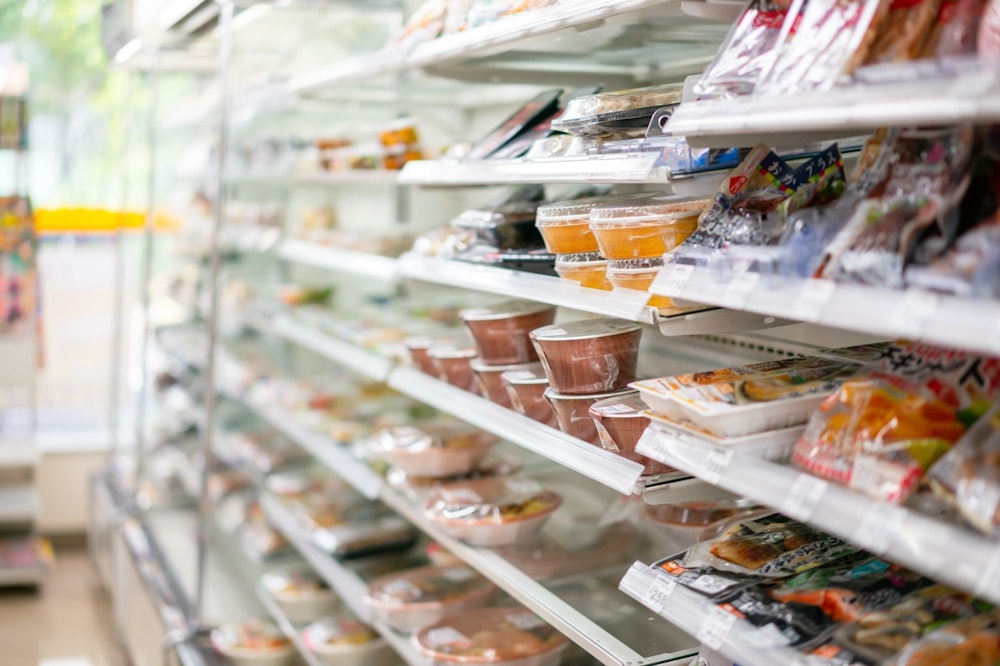
Photo:A convenience store in Japan
If you are craving udon, there are many options to choose from in Japan.
You can visit a restaurant and enjoy the taste of udon made by a professional, or you can order udon from a local restaurant online. You can also buy udon at supermarkets or convenience stores and enjoy it at home. For those of you looking to buy udon outside of Japan, we recommend trying your nearest Asian market.
The number of udon chain restaurants in Japan is increasing every year. Marugame Seimen and Hanamaru Udon, the two largest udon restaurants in the industry, are well known throughout Japan for their authentic Sanuki udon.
They are popular for their special udon noodles, unique dishes, abundant toppings, and affordable prices.
There are various types of local udon throughout Japan, and among them, Sanuki udon from Kagawa Prefecture is a famous type of udon characterized by its soft outer texture, but firmness when bitten into. You can purchase authentic Sanuki udon online, and enjoy the taste of the udon at home.
Other famous udon restaurants include Tsurutontan (つるとんたん), which has stores in Tokyo and Osaka, and Inaniwa udon from Kanbun Gonendo (寛文五年堂), which is carefully prepared by skilled artisans. The appeal of ordering udon online is that you can enjoy udon from different parts of Japan without having to visit them.
Although few in number, there are also udon vending machines in Japan. These are not cup noodles, but rather, the vending machine actually serves cooked udon. Back in the day, udon vending machines could be found all over Japan, but due to the emergence of convenience stores and fast-food restaurants, as well as security issues, the number of udon vending machines has decreased. Today, the locations where udon vending machines are located have become popular spots as sacred places for udon lovers.
Different Types of Udon From Various Parts of Japan
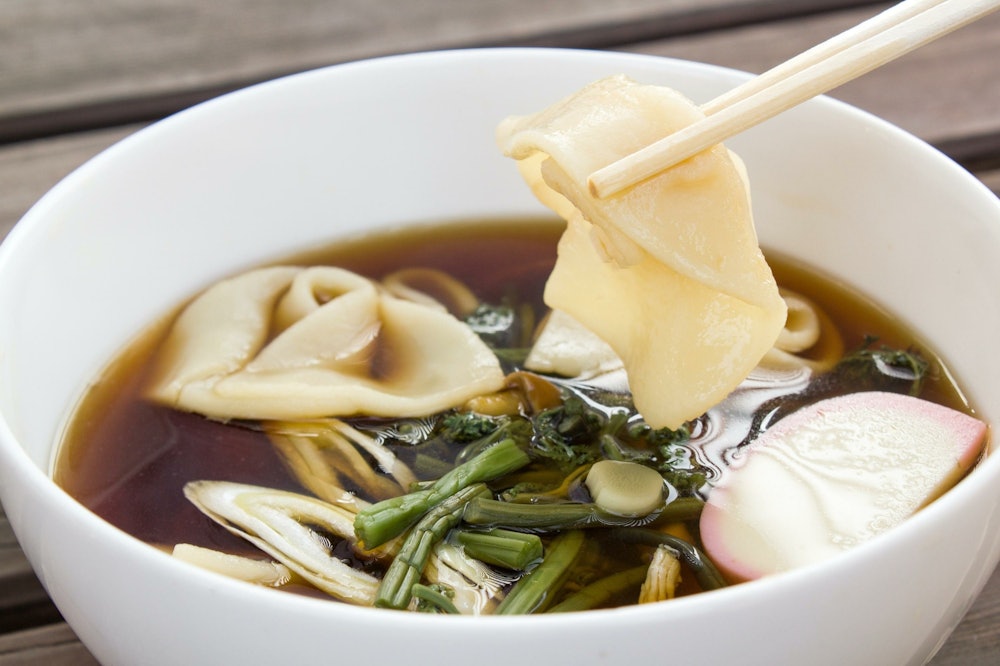
Photo:Mimi Udon, a specialty of Tochigi Prefecture
・Mimi Udon
One of the local dishes of Sano City, Tochigi Prefecture, this udon, whose name literally means "Ear Udon," is characterized by its ear-shaped noodles.
It is commonly eaten on New Year's in the Senba district of Sano, Tochigi.
・Tatebayashi Udon
Tatebayashi Udon is a traditional udon dish that originates from Tatebayashi Flour Milling, the predecessor to Nisshin Flour Milling.
Since 1994, it has been used as a means to promote tourism to the town of Tatebayashi in Gunma.
・Kiryu Udon
Kiryu Udon is eaten in the area centering on Kiryu, Gunma.
It is characterized by the use of wide noodles called "himokawa."
・Kumagaya Udon
Kumagaya udon is made from Kumagaya wheat, which is produced in Kumagaya, Saitama, the largest producer of wheat in the prefecture.
The flavor of the wheat and the ease with which the broth sinks into the noodles make it a dish that anyone can enjoy.
・Yoshida Udon
Yoshida Udon is a local dish eaten mainly in Fujiyoshida, Yamanashi. In 2007, it was selected by the Ministry of Agriculture, Forestry and Fisheries as one of the " Top 100 Local Dishes of Agricultural, Forestry and Fishing Villages."
There are other popular types of udon throughout Japan that have taken root in their local area, such as Toyohashi curry udon, gamagori udon, Ise udon, kasu udon, horumonyaki udon, bokkake udon, ume udon, Tsuyama horumon udon, Kure hoso udon, tarai udon, Ogura niku udon, Maruten udon, Sara udon, and many more.
Learn More About Udon via Videos and Posts on COOL JAPAN VIDEOS
COOL JAPAN VIDEOS is a social video curation site that introduces the charms of Japan to people all over the world.
In addition to the "channel" search, which allows users to search for articles by genre, such as sightseeing, food, and festivals, there is also a "region search" that allows users to narrow down their search by Japanese city, and a "tag search" that allows users to search by tags.
If you search for "udon" via the tag search on COOL JAPAN VIDEOS, you will find a variety of udon-related information.
In the "Posts" section of COOL JAPAN VIDEOS, you will find delicious photos of udon and voices of actual people, and in the "Trending" section, you will find a wide range of information about udon, including video articles introducing popular udon restaurants, delicious udon recipes, and video articles on how udon is made. There is a lot of interesting information about Japanese udon that you may not know. You are sure to discover something new and exciting about udon!
 Video article 3:37
Video article 3:37 Video article 4:25
Video article 4:25 Video article 2:22
Video article 2:22 Video article 1:21
Video article 1:21 Video article 5:29
Video article 5:29 Video article 3:28
Video article 3:28 Video article 9:46
Video article 9:46 Video article 2:36
Video article 2:36 Video article 4:29
Video article 4:29 Video article 8:59
Video article 8:59 Video article 0:54
Video article 0:54 Video article 7:10
Video article 7:10 Video article 3:37
Video article 3:37 Video article 4:29
Video article 4:29 Video article 1:46
Video article 1:46 Video article 8:59
Video article 8:59 Video article 7:10
Video article 7:10 Video article 4:10
Video article 4:10 Video article 2:36
Video article 2:36 Video article 8:17
Video article 8:17 Video article 1:21
Video article 1:21 Video article 9:46
Video article 9:46 Video article 2:22
Video article 2:22 Video article 7:28
Video article 7:28












